Ask a question from expert
Introduction to FIGURES 3 LIST OF FIGURES 3 ABSTRACT 4 ABSTRACT 5 ABSTRACT 4 ABSTRACT 5 INTRODUCTION 6 1.0 Introduction to the topic 6 1.1 Introduction to the company 10 1.3 Statement of the problem 1
56 Pages17116 Words197 Views
Added on 2021-07-23
About This Document
LIST OF FIGURES 3 LIST OF TABLES 4 ABSTRACT 5 INTRODUCTION 6 1.0 Chapter Introduction 6 1.1 Introduction to the topic 6 1.2 Introduction to the company 10 1.3 Statement of the problem 11 1.3.1 Research problem 11 1.3.2 Research Questions 12 1.4 Significance of the study 12 1.5 Objective of the study 13 1.5.1 Main Objective 13 1.5.2 Specific Objectives 13 1.6 Limitation of the study 13 LITREATURE REVIEW 15 2.0 Chapter Introduction 15 2.1 History of Occupational Health and
Introduction to FIGURES 3 LIST OF FIGURES 3 ABSTRACT 4 ABSTRACT 5 ABSTRACT 4 ABSTRACT 5 INTRODUCTION 6 1.0 Introduction to the topic 6 1.1 Introduction to the company 10 1.3 Statement of the problem 1
Added on 2021-07-23
BookmarkShareRelated Documents
Table of Contents
LIST OF FIGURES..................................................................................................................3
LIST OF TABLES....................................................................................................................4
ABSTRACT.............................................................................................................................5
INTRODUCTION....................................................................................................................6
1.0 Chapter Introduction.................................................................................................6
1.1 Introduction to the topic............................................................................................6
1.2Introduction to the company...................................................................................10
1.3 Statement of the problem........................................................................................11
1.3.1 Research problem............................................................................................11
1.3.2Research Questions.........................................................................................12
1.4 Significance of the study.........................................................................................12
1.5 Objective of the study.............................................................................................13
1.5.1 Main Objective................................................................................................13
1.5.2Specific Objectives.........................................................................................13
1.6 Limitation of the study............................................................................................13
LITREATURE REVIEW.......................................................................................................15
2.0 Chapter Introduction...............................................................................................15
2.1 History of Occupational Health and Safety.............................................................15
2.2Development of occupational health, safety............................................................15
2.3 Definition and Terms..............................................................................................16
2.4 Accident in the workplace.......................................................................................17
2.5 Hazards and near misses in the workplace..............................................................18
2.6 Impact of Employer concern on Industrial accidents..............................................19
2.7 Impact of Employee concern on Industrial accidents..............................................21
2.8 Importance of utilizing PPE’s (Personal Protective Equipments)...........................23
2.9 Prevent Industrial Accidents at the workplace........................................................24
RESEARCH METHODOLOGY............................................................................................27
3.0 Chapter Introduction...............................................................................................27
3.1 Conceptual framework............................................................................................27
3.1.1 Independent variables......................................................................................28
3.1.2Dependant variables........................................................................................28
3.2Developing Hypothesis...........................................................................................28
LIST OF FIGURES..................................................................................................................3
LIST OF TABLES....................................................................................................................4
ABSTRACT.............................................................................................................................5
INTRODUCTION....................................................................................................................6
1.0 Chapter Introduction.................................................................................................6
1.1 Introduction to the topic............................................................................................6
1.2Introduction to the company...................................................................................10
1.3 Statement of the problem........................................................................................11
1.3.1 Research problem............................................................................................11
1.3.2Research Questions.........................................................................................12
1.4 Significance of the study.........................................................................................12
1.5 Objective of the study.............................................................................................13
1.5.1 Main Objective................................................................................................13
1.5.2Specific Objectives.........................................................................................13
1.6 Limitation of the study............................................................................................13
LITREATURE REVIEW.......................................................................................................15
2.0 Chapter Introduction...............................................................................................15
2.1 History of Occupational Health and Safety.............................................................15
2.2Development of occupational health, safety............................................................15
2.3 Definition and Terms..............................................................................................16
2.4 Accident in the workplace.......................................................................................17
2.5 Hazards and near misses in the workplace..............................................................18
2.6 Impact of Employer concern on Industrial accidents..............................................19
2.7 Impact of Employee concern on Industrial accidents..............................................21
2.8 Importance of utilizing PPE’s (Personal Protective Equipments)...........................23
2.9 Prevent Industrial Accidents at the workplace........................................................24
RESEARCH METHODOLOGY............................................................................................27
3.0 Chapter Introduction...............................................................................................27
3.1 Conceptual framework............................................................................................27
3.1.1 Independent variables......................................................................................28
3.1.2Dependant variables........................................................................................28
3.2Developing Hypothesis...........................................................................................28

3.3 Study population and Sampling technique..............................................................29
3.3.1 Population.......................................................................................................29
3.3.2Sampling Technique.......................................................................................29
3.4 Data collection methods and procedures.................................................................30
3.4.1 Data Collection...............................................................................................30
3.4.2Data collection procedure................................................................................30
3.5 Data Analysing and Presentation............................................................................30
DATA ANALYSIS & PRESENTATION..............................................................................32
4.0 Chapter Introduction...............................................................................................32
4.1 Findings and Data analysis......................................................................................32
4.2.1. Analysis of Demographic factors....................................................................32
4.2.2. Analyse on Hypothesis....................................................................................35
CHAPTER 05.........................................................................................................................43
CONCLUTION AND RECOMMENDATION......................................................................43
5.0 Chapter Introduction...............................................................................................43
5.1 Conclusion..............................................................................................................43
5.1 Recommendations...................................................................................................43
REFERENCES.......................................................................................................................46
APPENDICES........................................................................................................................51
2
3.3.1 Population.......................................................................................................29
3.3.2Sampling Technique.......................................................................................29
3.4 Data collection methods and procedures.................................................................30
3.4.1 Data Collection...............................................................................................30
3.4.2Data collection procedure................................................................................30
3.5 Data Analysing and Presentation............................................................................30
DATA ANALYSIS & PRESENTATION..............................................................................32
4.0 Chapter Introduction...............................................................................................32
4.1 Findings and Data analysis......................................................................................32
4.2.1. Analysis of Demographic factors....................................................................32
4.2.2. Analyse on Hypothesis....................................................................................35
CHAPTER 05.........................................................................................................................43
CONCLUTION AND RECOMMENDATION......................................................................43
5.0 Chapter Introduction...............................................................................................43
5.1 Conclusion..............................................................................................................43
5.1 Recommendations...................................................................................................43
REFERENCES.......................................................................................................................46
APPENDICES........................................................................................................................51
2
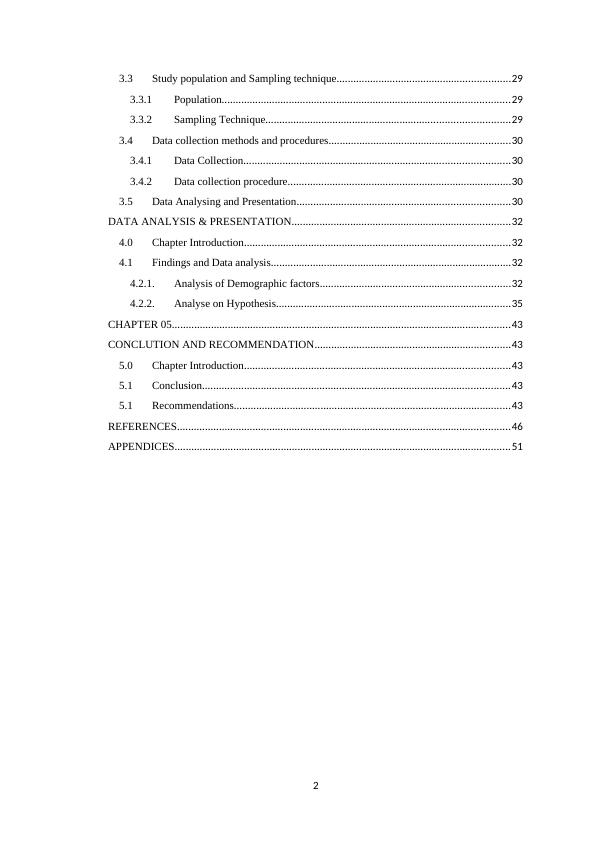
LIST OF FIGURES
Figure 01 - Conceptual framework ......................................................................27
Figure 02 – Demographic factors .........................................................................33
Figure 03 – Accidents Level.................................................................................35
3
Figure 01 - Conceptual framework ......................................................................27
Figure 02 – Demographic factors .........................................................................33
Figure 03 – Accidents Level.................................................................................35
3
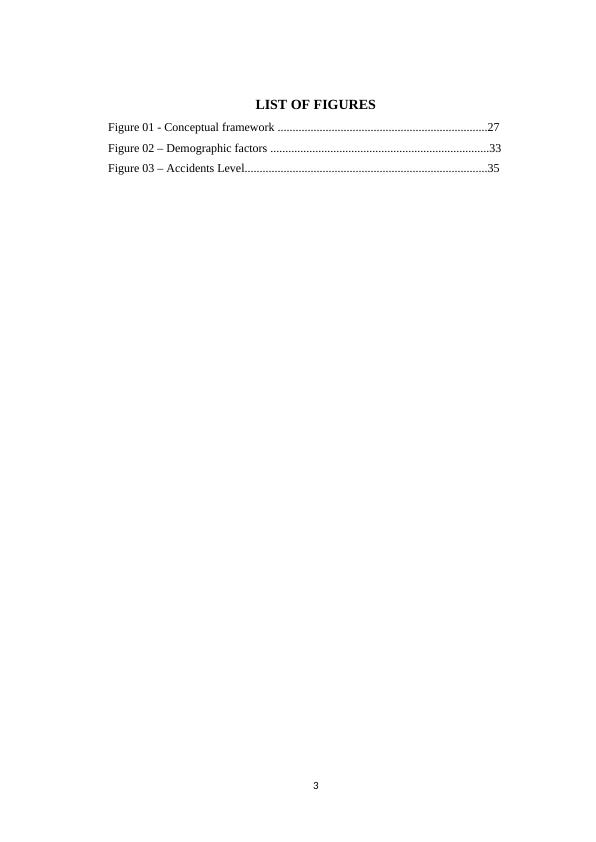
LIST OF TABLES
Table 01 - Demographic factor analysis............................................................34
Table 02 - Accidents rate of the organization....................................................35
Table 03 - Summary of the Data analysis..........................................................36
Table 04 - Spearman correlation test results for the relationships
between the Management concern on safety and the Industrial
accidents of the work place ............................................................38
Table 05 - Spearman correlation test results for the relationships
between the Employee concern on safety and the Industrial
accidents of the work place ............................................................40
Table 06 - Spearman correlation test results for the relationships
between the Employee concern on safety and the Industrial
accidents of the work place ............................................................41
4
Table 01 - Demographic factor analysis............................................................34
Table 02 - Accidents rate of the organization....................................................35
Table 03 - Summary of the Data analysis..........................................................36
Table 04 - Spearman correlation test results for the relationships
between the Management concern on safety and the Industrial
accidents of the work place ............................................................38
Table 05 - Spearman correlation test results for the relationships
between the Employee concern on safety and the Industrial
accidents of the work place ............................................................40
Table 06 - Spearman correlation test results for the relationships
between the Employee concern on safety and the Industrial
accidents of the work place ............................................................41
4
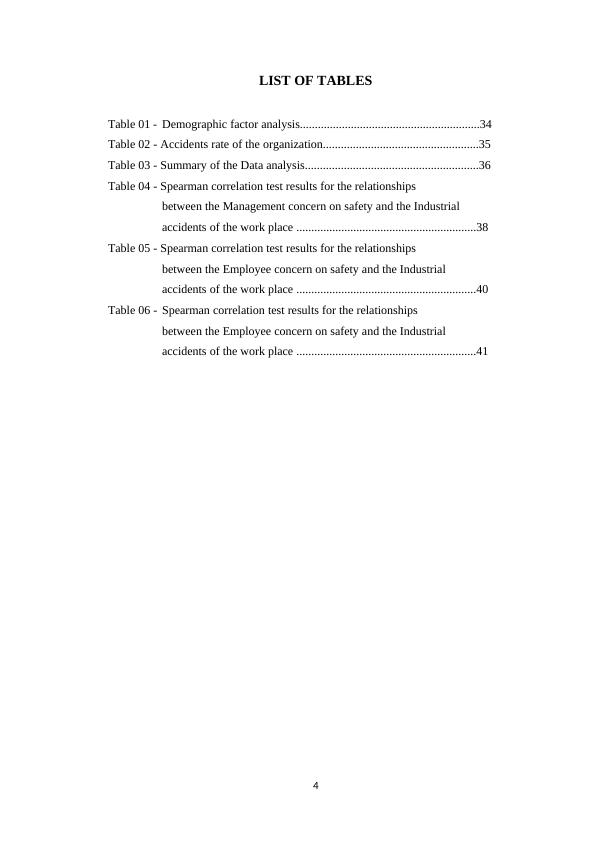
ABSTRACT
Industrial Accidents of any organization will affect the productivity of the
organization. Industrial accidents should be prevented and it is necessary of
understanding factors affecting to the industrial accidents of the organization.
Management concern, Employee concern and Utilization of Personal Protective
Equipment (PPE’s).The above factors have an influence on Industrial accidents of the
organization. The study is based on the Impact of Employer and Employee concern on
Industrial accidents of the organization. Data collection was done by using an
interviewer administrated structured questionnaire. The sample consists of employees
from Sri Lanka leading manufacturing company. Simple random sampling method
was used for the data collection. As a result of factor analysis, Employer concern and
Utilization of PPE’s has a relationship with the Industrial accidents which is a
negative relationship, in Employer concern Management involvement on safety
procedures of the organization, Proper Health and safety program providing, Actions
taken for the reported issues, New employee trainings, management observation on
safety even when employees are busy, also in Utilization of PPE’s Well proving of
PPE’s, Quality of the PPE’s and the management observation on PPE’s used by the
employees. These variables have a relationship with the Industrial accident of the
organization. Since these variables have negative weak relationship once these
variables increase the level of industrial accidents will increase but will not have an
influence always on the Industrial accidents. Hence according to the analysis in order
to reduce the accidents of the organization, management could have proper
involvement by having safety audits, analyzing on safety issues and providing proper
training programs with help by external expertise. Also providing proper and quality
PPE’s and observe on employees whether the employees are utilizing PPE’s well. so
that management can get a support from these external PPE suppliers and provide
good and quality PPE’s to the employees. But since the variable does not have a
strong relationship with the Industrial accidents of the organization further studies
should be carried on in order to analyze the Factors affecting to the Industrial
accidents of the Organization
Key words – Health & Safety, Industrial accidents, Employee, employer,
Personal Protective Equipment’s
5
Industrial Accidents of any organization will affect the productivity of the
organization. Industrial accidents should be prevented and it is necessary of
understanding factors affecting to the industrial accidents of the organization.
Management concern, Employee concern and Utilization of Personal Protective
Equipment (PPE’s).The above factors have an influence on Industrial accidents of the
organization. The study is based on the Impact of Employer and Employee concern on
Industrial accidents of the organization. Data collection was done by using an
interviewer administrated structured questionnaire. The sample consists of employees
from Sri Lanka leading manufacturing company. Simple random sampling method
was used for the data collection. As a result of factor analysis, Employer concern and
Utilization of PPE’s has a relationship with the Industrial accidents which is a
negative relationship, in Employer concern Management involvement on safety
procedures of the organization, Proper Health and safety program providing, Actions
taken for the reported issues, New employee trainings, management observation on
safety even when employees are busy, also in Utilization of PPE’s Well proving of
PPE’s, Quality of the PPE’s and the management observation on PPE’s used by the
employees. These variables have a relationship with the Industrial accident of the
organization. Since these variables have negative weak relationship once these
variables increase the level of industrial accidents will increase but will not have an
influence always on the Industrial accidents. Hence according to the analysis in order
to reduce the accidents of the organization, management could have proper
involvement by having safety audits, analyzing on safety issues and providing proper
training programs with help by external expertise. Also providing proper and quality
PPE’s and observe on employees whether the employees are utilizing PPE’s well. so
that management can get a support from these external PPE suppliers and provide
good and quality PPE’s to the employees. But since the variable does not have a
strong relationship with the Industrial accidents of the organization further studies
should be carried on in order to analyze the Factors affecting to the Industrial
accidents of the Organization
Key words – Health & Safety, Industrial accidents, Employee, employer,
Personal Protective Equipment’s
5
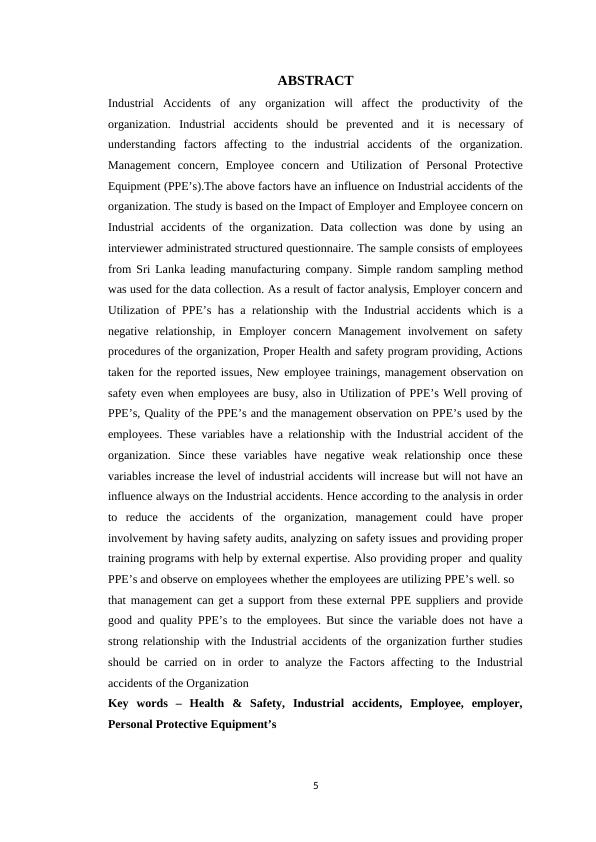
CHAPTER 01
INTRODUCTION
1.0 Chapter Introduction
Health and Safety is an important aspect of an organization, this chapter will
emphasise how it has been implemented and how it has been developed with the
various Health and Safety standards. Industrial Accidents could e directly influence to
the peoples’ lives hence it should be prevented, this chapter will also describe how it
could be affected to the society and how it could be prevented with Employer,
Employee involvement.
1.1 Introduction to the topic
Introduction to occupational safety and health
Health and Safety is an important aspect of an organization, this chapter will
emphasise the development of health and safety and what are the importance of it,
Most of the health and safety standards implemented after the industrial revolution
and International Labour Organization has been introduced 40 standards for
occupational health and safety in order to reduce industrial accidents of the
organization
Occupational safety and health generally defines as the science of the
anticipation, recognition, evaluation and control of hazards arising in the workplace
that could impair the health and wellbeing of the workers, taking into account the
possible impact on surrounding communities and the general environment (Alli,
2008). A healthy workforce is a vital or sustainable social and economic development
on a global, national and local level. The classic approach to ensuring health and
safety in the workplace has depended mainly on the enactment of the legislation and
inspection of workplaces ensure compliance with health and safety standards. While
this approach has been effective in controlling many specific occupational hazards
since the industrial revolution. It has not been very effective in the past several
decades, particularly in developing countries, for several reasons (John Shimwell,
2000)
The ILO Constitution sets forth the principle that workers should be protected
from sickness, disease and injury arising from their employment, In 2003 the ILO
adopted an global strategy to improve occupational safety and health which included
6
INTRODUCTION
1.0 Chapter Introduction
Health and Safety is an important aspect of an organization, this chapter will
emphasise how it has been implemented and how it has been developed with the
various Health and Safety standards. Industrial Accidents could e directly influence to
the peoples’ lives hence it should be prevented, this chapter will also describe how it
could be affected to the society and how it could be prevented with Employer,
Employee involvement.
1.1 Introduction to the topic
Introduction to occupational safety and health
Health and Safety is an important aspect of an organization, this chapter will
emphasise the development of health and safety and what are the importance of it,
Most of the health and safety standards implemented after the industrial revolution
and International Labour Organization has been introduced 40 standards for
occupational health and safety in order to reduce industrial accidents of the
organization
Occupational safety and health generally defines as the science of the
anticipation, recognition, evaluation and control of hazards arising in the workplace
that could impair the health and wellbeing of the workers, taking into account the
possible impact on surrounding communities and the general environment (Alli,
2008). A healthy workforce is a vital or sustainable social and economic development
on a global, national and local level. The classic approach to ensuring health and
safety in the workplace has depended mainly on the enactment of the legislation and
inspection of workplaces ensure compliance with health and safety standards. While
this approach has been effective in controlling many specific occupational hazards
since the industrial revolution. It has not been very effective in the past several
decades, particularly in developing countries, for several reasons (John Shimwell,
2000)
The ILO Constitution sets forth the principle that workers should be protected
from sickness, disease and injury arising from their employment, In 2003 the ILO
adopted an global strategy to improve occupational safety and health which included
6

the introduction of a preventive safety and health culture, the promotion and
development of relevant instruments, and technical assistance, The ILO has adopted
more than 40 standards specifically dealing with occupational safety and health, as
well as over 40 Codes of Practice. Nearly half of ILO instruments deal directly or
indirectly with occupational safety and health issues ( ILO standards on occupational
health)
Impact of Industrial accidents to the society
Though it has several standards still in every 15 seconds a worker dies from a
work related accident or disease, and it may not only affect to the employees, but for
his family, friends and co workers as well. So that it is important of prevent industrial
accidents of the organization since it is immeasurable and will have a major impact on
the society. In order to prevent accidents of the organization it is important of
identifying the hazards of the organization. This chapter well describe how could
Industrial Accidents could be reduced by identifying hazards of the organization
Every 15 seconds; a worker dies from a work-related accident or disease. Every
15 seconds, 153 workers have a work-related accident. Every day, 6,300 people die as
a result of occupational accidents or work-related diseases. More than 2.3 million
deaths per year. 317 million accidents occur on the job annually ("Safety and Health
at Work". Ilo.org, 2017). A serious workplace injury or death could affect for the
people’s whole life, family, friends and their co-workers. Occupational injuries could
provoke major crisis to their family members and in the other hand it will give a
major impact for a financial loss as well, Human injuries or deaths are immeasurable.
It will also affect to the organizational wellbeing and the productivity as well,
therefore every person who goes to work in the morning should return home in good
health. ("The Importance of Safety - Work safest". Work Safest, 2017).
An occupational hazard is a thing or situation with which could harm for the
worker it could be divided into two categories: safety hazards that cause accidents that
physically injure workers, and health hazards which result in the development of
disease. Hazards can be rated according to the severity of the harm they cause - a
significant hazard being one with the potential to cause a critical injury or death.
Removing occupational hazards is only one way of improving worker protection.
What is often more practical is the control or management of the risks that hazards
pose. Sometimes, in addition to the probability of a hazard causing harm, risk includes
7
development of relevant instruments, and technical assistance, The ILO has adopted
more than 40 standards specifically dealing with occupational safety and health, as
well as over 40 Codes of Practice. Nearly half of ILO instruments deal directly or
indirectly with occupational safety and health issues ( ILO standards on occupational
health)
Impact of Industrial accidents to the society
Though it has several standards still in every 15 seconds a worker dies from a
work related accident or disease, and it may not only affect to the employees, but for
his family, friends and co workers as well. So that it is important of prevent industrial
accidents of the organization since it is immeasurable and will have a major impact on
the society. In order to prevent accidents of the organization it is important of
identifying the hazards of the organization. This chapter well describe how could
Industrial Accidents could be reduced by identifying hazards of the organization
Every 15 seconds; a worker dies from a work-related accident or disease. Every
15 seconds, 153 workers have a work-related accident. Every day, 6,300 people die as
a result of occupational accidents or work-related diseases. More than 2.3 million
deaths per year. 317 million accidents occur on the job annually ("Safety and Health
at Work". Ilo.org, 2017). A serious workplace injury or death could affect for the
people’s whole life, family, friends and their co-workers. Occupational injuries could
provoke major crisis to their family members and in the other hand it will give a
major impact for a financial loss as well, Human injuries or deaths are immeasurable.
It will also affect to the organizational wellbeing and the productivity as well,
therefore every person who goes to work in the morning should return home in good
health. ("The Importance of Safety - Work safest". Work Safest, 2017).
An occupational hazard is a thing or situation with which could harm for the
worker it could be divided into two categories: safety hazards that cause accidents that
physically injure workers, and health hazards which result in the development of
disease. Hazards can be rated according to the severity of the harm they cause - a
significant hazard being one with the potential to cause a critical injury or death.
Removing occupational hazards is only one way of improving worker protection.
What is often more practical is the control or management of the risks that hazards
pose. Sometimes, in addition to the probability of a hazard causing harm, risk includes
7
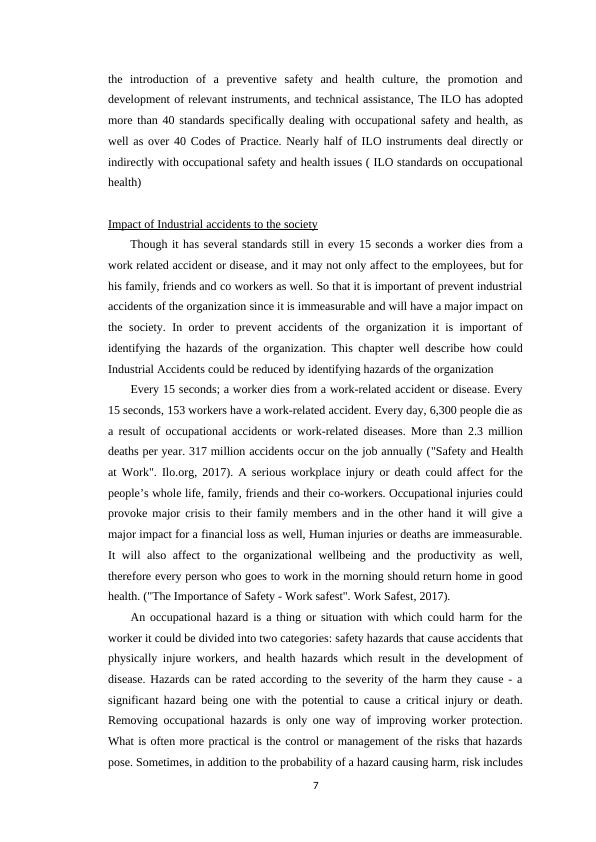
a consideration of the seriousness of the hazard. There are three steps of removing
hazard of the organization, first it should be recognized, assessed and controlled.
(Ontario Ministry of Labour, 2016) hence controlling hazards are important of
creating a safety culture of the organization
Past study indicated that an introduction of safety culture can be seen as a
solution to the incremental accident cases in the workplace (Sukadarin, 2012)
Organization culture in terms of the beliefs and values of the organization which act
as prescription for the way in which organizational members should work. “safety
culture’’ may be perceived as a subset of the organizational culture where the beliefs
and values refer specifically to maters in health and safety (Harrison, 1970) so the
making a proper safety culture always matters in health and safety, hence
management of the organization has a major responsibility of creating a proper safety
culture of the organization. Perception of the senior manager’s attitude and behaviours
in relation to the safety and wellbeing of the workforce (Schein, 1992)
This study is focusing on factors affecting in industrial accidents in special
reference to Employer, Employee concern and using Personal Protective Equipment’s
of the ABC (Ceylon) PLC. Employee and the Employer concern is really important
on preventing industrial accidents if the organization.
Impact of Employee concern on Industrial Accidents
Employee concern on industrial accidents has a major impact on reducing
industrial accidents of the organization. Employees should be responsible for
protecting own self from the accidents. This chapter will describe how employee
should be concern on industrial accidents and how to reduce it proper involvement
Workplace safety perception has a number of elements, which include employee
attitudes, awareness programs, employee involvement, safety goals, safety policy,
procedure and regulations, safety management, safety assessments, communication,
discipline, training, hazard elimination, supervision, award and punishment,
housekeeping and support for safety.. Employees with good safety perception produce
high quality products and services, work at a higher efficiency, The employee
workplace safety perception depends on the owner and the management’s attitude
towards safety ("What Is Workplace Safety Perception?” - Definition from
Safeopedi,2017) Another past study has emphasize that workers knowledge on and
compliance to, workers attitudes towards safety, workers participation and
8
hazard of the organization, first it should be recognized, assessed and controlled.
(Ontario Ministry of Labour, 2016) hence controlling hazards are important of
creating a safety culture of the organization
Past study indicated that an introduction of safety culture can be seen as a
solution to the incremental accident cases in the workplace (Sukadarin, 2012)
Organization culture in terms of the beliefs and values of the organization which act
as prescription for the way in which organizational members should work. “safety
culture’’ may be perceived as a subset of the organizational culture where the beliefs
and values refer specifically to maters in health and safety (Harrison, 1970) so the
making a proper safety culture always matters in health and safety, hence
management of the organization has a major responsibility of creating a proper safety
culture of the organization. Perception of the senior manager’s attitude and behaviours
in relation to the safety and wellbeing of the workforce (Schein, 1992)
This study is focusing on factors affecting in industrial accidents in special
reference to Employer, Employee concern and using Personal Protective Equipment’s
of the ABC (Ceylon) PLC. Employee and the Employer concern is really important
on preventing industrial accidents if the organization.
Impact of Employee concern on Industrial Accidents
Employee concern on industrial accidents has a major impact on reducing
industrial accidents of the organization. Employees should be responsible for
protecting own self from the accidents. This chapter will describe how employee
should be concern on industrial accidents and how to reduce it proper involvement
Workplace safety perception has a number of elements, which include employee
attitudes, awareness programs, employee involvement, safety goals, safety policy,
procedure and regulations, safety management, safety assessments, communication,
discipline, training, hazard elimination, supervision, award and punishment,
housekeeping and support for safety.. Employees with good safety perception produce
high quality products and services, work at a higher efficiency, The employee
workplace safety perception depends on the owner and the management’s attitude
towards safety ("What Is Workplace Safety Perception?” - Definition from
Safeopedi,2017) Another past study has emphasize that workers knowledge on and
compliance to, workers attitudes towards safety, workers participation and
8
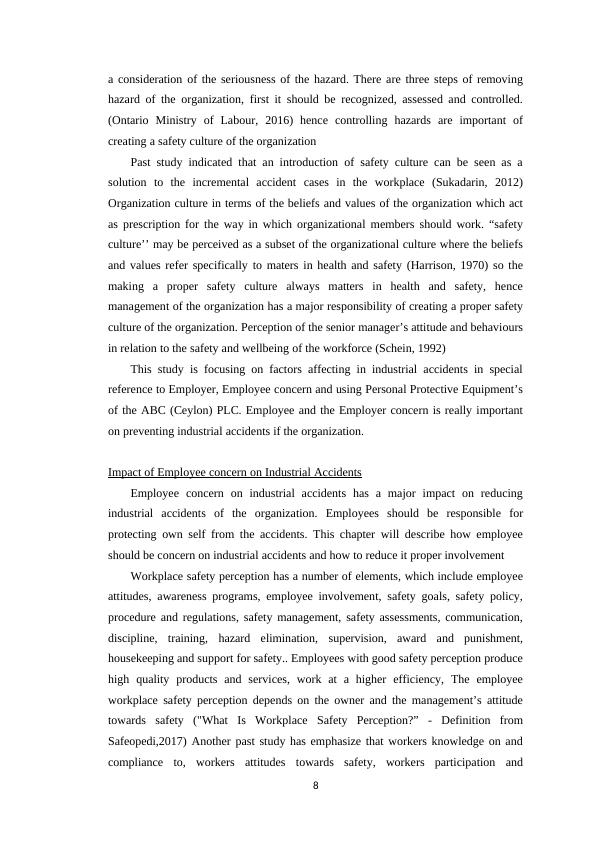
End of preview
Want to access all the pages? Upload your documents or become a member.
Related Documents
Statistics online examlg...
|6
|395
|54
The Effects of Performance Appraisal System on Employees’ Performance in the Public Service of Jamaica – A Case Study of the Jamaica Constabulary Forcelg...
|70
|22885
|249
Impacts of Fear of Project Failure on Project Outcomes: Does Leveraging Stress lead to IT Project Success or Failurelg...
|107
|24942
|367
Research Report on Safety Management Systemlg...
|70
|16034
|30
Impact of Employee Motivation on Organizational Performance in McDonaldslg...
|100
|22482
|61
A Study Of The Structure And Function Of The................................................................................................................3 1.3.1. General Objectives 5 1.3.2. Specifilg...
|51
|17075
|164